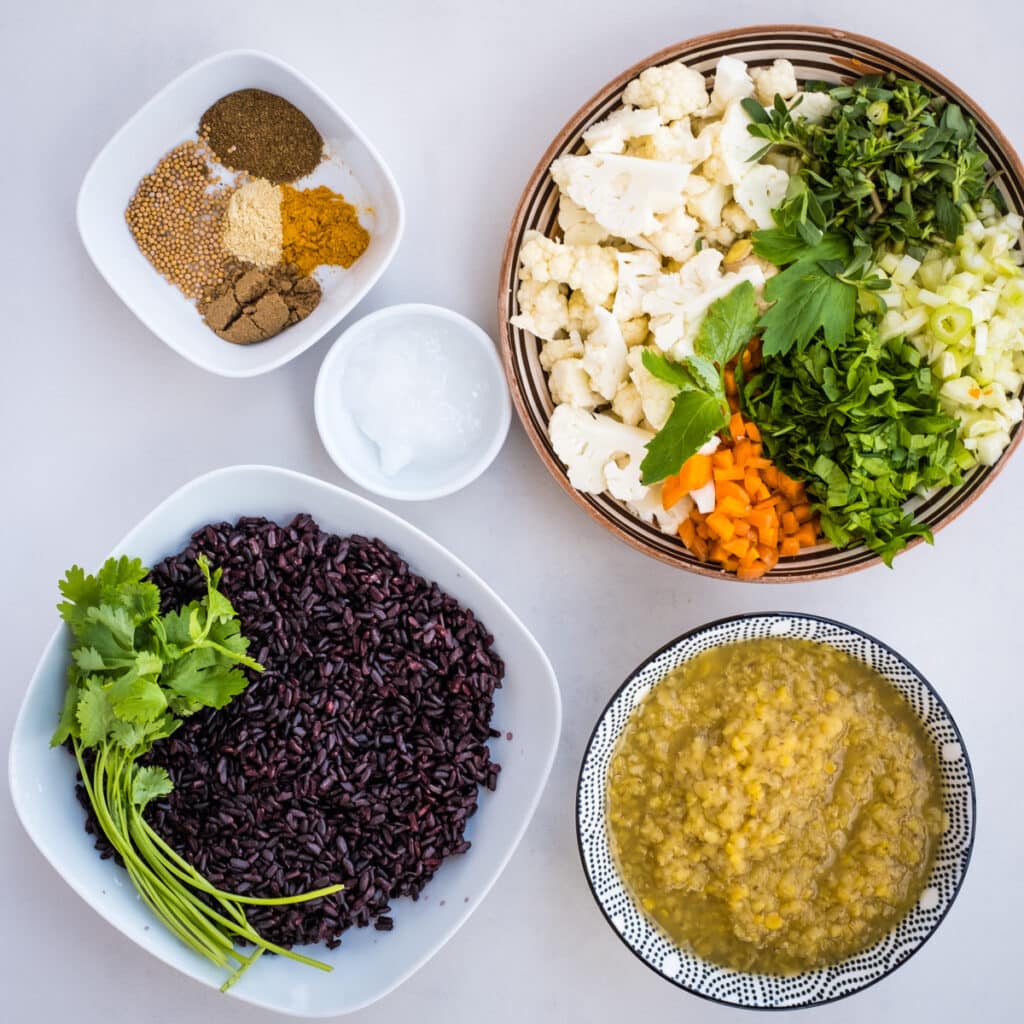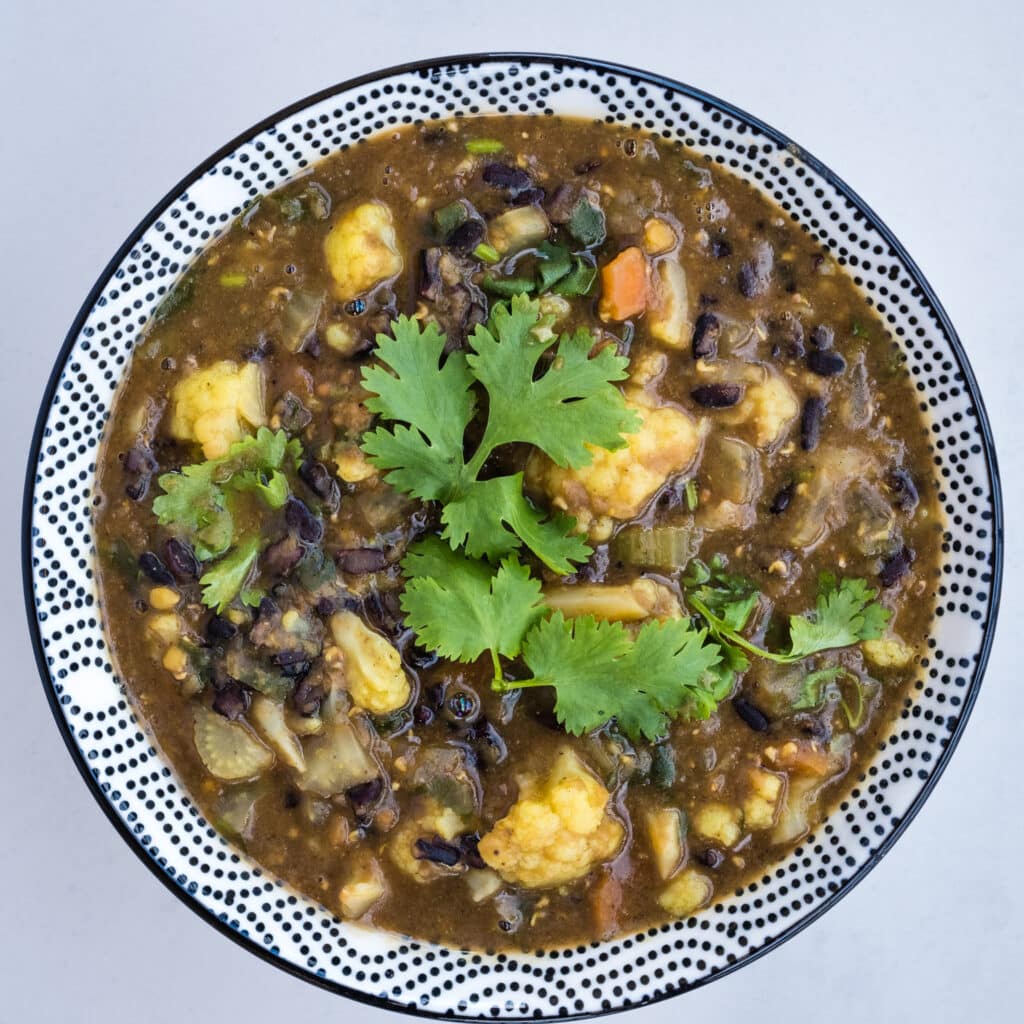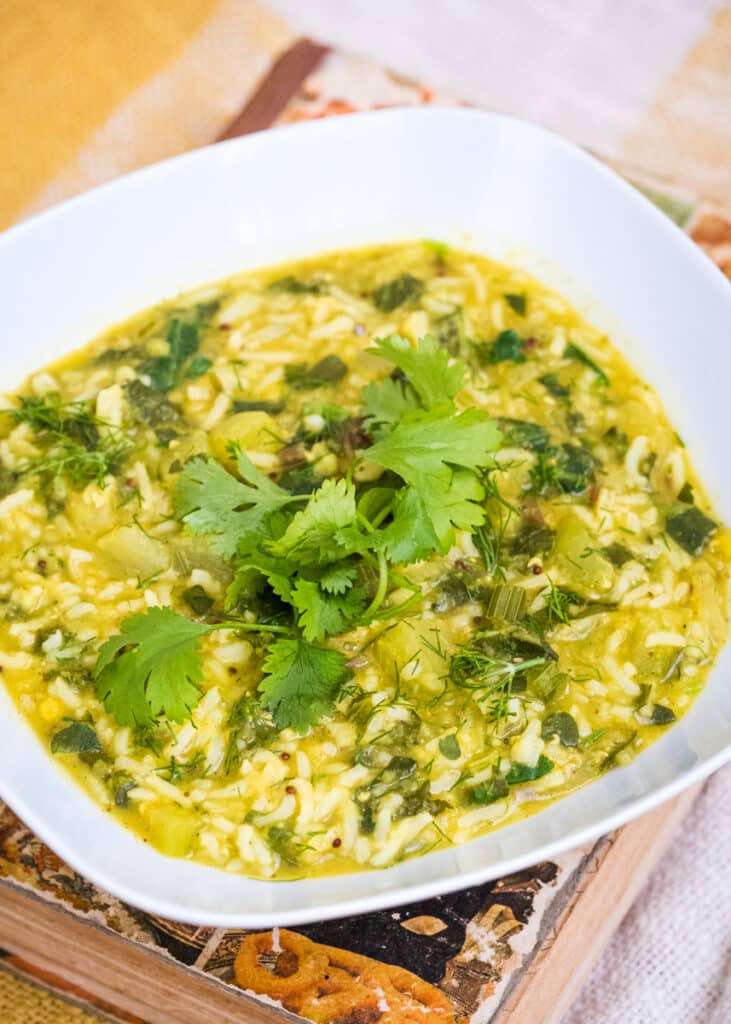Inspired by Ayurvedic principles, I adapted this kitchari recipe to suit a low-lectin diet. Eat this vegan, low-lectin kitchari for three consecutive days to give your digestive system a well-deserved break.
If you are not up for an ayurvedic cleanse, simply prepare this meal when you feel like nourishing and comforting food that is also easy to digest.
Ayurvedic cleanse for digestive discomfort
Lately, I’ve been interested in learning more about Ayurveda and integrating some of the traditional ayurvedic principles into my lifestyle.
According to Ayurveda, our health depends on what we eat and how our body is able to transform those foods into nutrients and energy. Agni, or the digestive fire, is responsible for the proper digestion of the foods we consume.
Do you have moments when you feel like no matter what you eat, you don’t feel your best? I do, and I found this 3-day ayurvedic cleanse helps me. For me, it’s mainly heartburn, but it can be any digestive discomfort such as feeling bloated, having irregular bowel movements, or feeling nauseous after you eat.
There are three doshas in Ayurveda: Pitta, Vata, and Kapha. According to Ayurveda, knowing your dosha and your imbalances will help you lead a more balanced and healthy life.
What I like about kitchari is that it is considered “tri doshic”, so it can be applied to all doshas. You don’t have to know your dosha to do this cleanse, and you don’t even have to know anything about Ayurveda. It truly is a soothing meal that should be tolerated by most people.
If you are new to Ayurveda and are interested to learn more, these are some accounts of Ayurveda practitioners I follow on Instagram:
- Deepak Chopra, @deepakchopra
- Sahara Rose, @Iamsahararose
- Nidhi Pandya, @my_ayurvedic_life
- Tomaz Mueller, @muelletomaz
What is a low-lectin Kitchari recipe?
Kitchari means mixture, usually of two grain: rice and mung daal or moong daal, which is the Ayurvedic name for split mung beans. It is used in the Ayurvedic cleanse because it is nourishing and easy to digest. There are more variations of it, but it usually works for all three doshas.
At first sight, kitchari seems an impossible dish when you follow a lectin-free or low-lectin diet. Beans and most grains are loaded with lectins, right? I recommend reading my article ‘The 4 Gut-Healthy, Gluten-Free and Lectin-Free grains’ for more insight on grains.
Well, there are certain ways to prepare these foods to eliminate most of the lectins and other anti-nutrients that may be affecting your digestion.
Does rice have lectins?
The way we consume rice and grains, in general, has an interesting story. About one thousand years ago, higher class members of society switched to eating refined rice. They realized the whole rice is harder to digest and causes discomfort.
That’s because antinutrients like phthalates and lectins are mostly concentrated in the outer hull. For many centuries, whole wheat grains were only consumed by the middle class and the poor.
However, in the 1920s and again in the 1960s, white, refined grains started to be seen as symbols of the bourgeoisie and fake purity, and a rebellious movement against white grains was born. Whole grains became a dietary preference in the 1970s, in the United States, when the benefits of fiber were discovered.
Fast forward to the present, and we have a nutritional debate between those who think the fiber in whole grains is healthy and those who recognize that the antinutrients in the outer hull cause digestive problems and can lead to autoimmune conditions.
So, strictly talking about lectins, phthalates, and arsenic, white rice is healthier than whole or brown rice because it is stripped of antinutrients and is lower in arsenic.
Indian Basmati rice (coming from India or Pakistan), and California rice are considered healthier options because of their lower concentration of arsenic (up to three times less). That is the reason why white, Indian Basmati rice, is the preferred rice in The Plant Paradox program.
In The Energy Paradox, a more recent book by Dr. Steven Gundry, there are three types of rice considered “mitochondrial must-haves” because of their high melatonin content:
- Red rice
- Black rice (also called forbidden rice)
- White Basmati rice
To remove most antinutrients in these three types of rice and enjoy their benefits, we must:
- Rinse well (until the water comes out clear)
- Soak for a minimum one hour and change the water several times
- Pressure-cook
- Cool in the refrigerator before reheating and eating
That’s why I choose these three types of rice to make kitchari, and I pressure cook and cool the rice before adding it to the dish.
Even according to Ayurveda, white Basmati rice is the best rice for digestion, balancing all three doshas.
Does brown rice have lectins?
All this must be confusing—so many types of rice, so many colors, and so much contradictory nutritional advice. First, let’s clarify what brown rice is.
According to Wikipedia: “Brown rice is whole grain rice with the inedible outer hull removed. This kind of rice sheds its outer hull or husk but the bran and germ layer remain on, constituting the brown or tan color of rice. White rice is the same grain without the hull, the bran layer, and the cereal germ. Red rice, gold rice, and black rice (also called purple rice) are all whole rice with differently pigmented outer layers.”
Brown rice is heavy in lectins and phthalates and has a high concentration of arsenic, and for this reason, it should be avoided. A good way to remove some of these toxins is soaking and rinsing.
Do lentils have lectins?
Yes, lentils have lectins, like all legumes and beans, but they can be removed by pressure cooking.
Kitchari Ingredients
- Fat: coconut oil, extra virgin olive oil, or grass-fed ghee (sesame oil can also be used). You can use a moderate quantity of any of these fats. Fat helps with digestion and the optimal absorption of nutrients.
- Spices: 1 teaspoon ground cumin (or cumin seeds), 1 teaspoon mustard seeds, 1 teaspoon fennel seeds, 1/2 teaspoon ground coriander, 1/2 teaspoon turmeric powder, 1 teaspoon grated fresh ginger, 1/2 teaspoon fenugreek powder. Spices are important in an ayurvedic cleanse.
- Beans/legumes: red lentils or mung dal (or moong dal, beans that have been skinned and split). According to Ayurveda, mung dal is the easiest to digest from all beans; that’s why it is the favorite ingredient in kitchari. However, from my experience, mung dal might not be easy to find, so the next best thing is red lentils. Whichever one you decide to use, you will have to pressure-cook them.
- Grain: black rice or Indian basmati rice. To make a low-lectin kitchari, I pressure-cook and cool rice in advance. If you are using black rice, the meal color will be dark.
- Seasonal vegetables: I use a few cups of seasonal, easy-to-digest vegetables such as cauliflower, celery leaves, purslane, carrot, and fennel bulb. You can also use asparagus, sweet potato, broccoli, and leafy greens.
- Liquid: 2 1/2 to 3 cups of water.
- Fresh chopped cilantro and lemon juice or lime juice for serving.

The main rules of this low-lectin Ayurvedic cleanse
- While eating leftovers is not recommended in Ayurveda, there is some room for flexibility, and I make double or triple portions. I usually cook a fresh batch before dinner and have the leftovers for the two meals the next day.
- Eat enough to feel satisfied but not overly full.
- This meal is the only food you will eat for three consecutive days, two times a day. You can eat three meals a day if you prefer. Don’t eat any other processed foods.
- You can make variations of this meal by changing the seasonal vegetables you use.
- Take a walk after every meal.
- Don’t take a bath or shower after a meal.
- Hydrate well, drinking herbal teas and room temperature or warm water. Don’t consume cold drinks.
- Don’t snack.
- Rest, meditate, breathe, journal, spend time in nature, and do physical work like cleaning and working in the garden.
- Avoid endocrine disruptors in cosmetic products, cookware, and cleaning products.

More benefits to a low-lectin kitchari
There are more benefits to eating this type of meal for three days. According to Dr. Steven Gundry in The Energy Paradox, mono meals are easy to digest and can boost your energy and well-being. A mono meal is made of mainly one macronutrient, in this case, carbohydrates.
This low-lectin kitchari, combined with vegan, time-restricted fasting, will not only give your digestive system a break but will give your mitochondria a chance to recover and will help re-establish your body’s and your microbiome’s circadian rhythms.

If you want to try a 5-day fasting-mimicking diet, you can make this low-lectin kitchari recipe part of your plan. You find more details in the below article:
For a different style cleanse, Phase 1 Plant Paradox compliant, with an easy meal plan, check out our 3-Day Cleanse to Lose Belly Fat (and Feel Better!).
*This post contains affiliated links, which means I get a small commission if you choose to purchase something via one of my links, at no extra cost to you.
Print
Healthy Low-Lectin Kitchari
- Prep Time: 40 minutes
- Cook Time: 40 minutes
- Total Time: 1 hour 20 minutes
- Yield: 3
Description
Inspired by Ayurvedic principles, I adapted this kitchari recipe to suit a low-lectin diet. Eat this vegan, low-lectin kitchari for three consecutive days to give your digestive system a well-deserved break. If you are not up for an ayurvedic cleanse, simply prepare this meal when you feel like nourishing and comforting food that is also easy to digest.
Ingredients
- 1/2 cup black rice OR Indian basmati rice (preferably organic)
- 1 tablespoon coconut oil (extra virgin olive oil or ghee can be used)
- 1 cup red lentils OR mung daal
- A few cups of seasonal, easy to digest vegetables such as cauliflower, celery leaves, purslane, zucchini (no peel and seeds), carrot, a fennel bulb, asparagus, sweet potato, broccoli, leafy greens
- Himalayan pink salt, to taste
- Spices: 1 teaspoon ground cumin, 1 teaspoon mustard seeds, 1 teaspoon fennel seeds, 1/2 teaspoon ground coriander, 1/2 teaspoon turmeric powder, 1 teaspoon grated ginger, 1/2 teaspoon fenugreek powder
- 2 1/2 to 3 cups of water
- Fresh cilantro for serving
Instructions
- Prepare in advance: rinse the rice, soak for one hour or even more, change the water several times, and pressure-cook it for 10 minutes with enough water, allowing a natural release of pressure. Drain excess water and let it cool (a few hours in the fridge or overnight). If you make the dish with Indian Basmati rice, follow the same steps, but Indian Basmati rice will only need 4 minutes to pressure cook. If you want to use an exact amount of water, use a 1:1 ratio (this way, you won’t have to drain the excess water).
- Rinse the lentils and pressure cook for 4 minutes, with enough water, allowing a natural release of pressure. Scoop the lentils out and discard the liquid.
- While the lentils are cooking, chop the cauliflower into small pieces. Chop the rest of the veggies. Whatever veggies you are using, it’s important they are well cooked, so add them in the order of the time they need to cook. Cauliflower would take longer than zucchini and asparagus for example. The leafy green can be added in the last 10 minutes.
- Heat the coconut oil on medium heat, add the cumin, coriander, mustard seeds, fennel seeds and cook for a few minutes until the oil gets fragrant (do not burn the spices).
- Add the cauliflower and other hard veggies (celery, carrots, fennel), stir well, add the ginger, turmeric and fenugreek.
- Add 2 1/2 cups of hot water over the veggies, or enough to cover them, and simmer for about 20 minutes, or until the cauliflower is tender.
- Add the rice and the lentils. If you use any tender green leaves like spinach, you can add them now. Add salt. Simmer for about 10 more minutes. Add more water if necessary. The consistency should be creamy, porridge-like. Keep in mind that when it cools down, the ingredients absorb more liquid.
- Serve with fresh cilantro, add more salt if necessary.
Notes
While eating leftovers is not recommended in Ayurveda, you can eat this kitchari the next day or the next meal if cooking for every meal doesn’t fit your lifestyle. This is a vegan, lectin-light, nourishing, and satisfying meal.

8 Comments
Suzanne
March 4, 2024 at 12:58 pmFirst of all, I love your cookbooks! I am looking forward to trying this along with your other cleanses.
I have my biannual chemo infusion in a couple weeks & while it helps with what is supposed to, it also does a number on my digestive system. I was thinking that doing a cleans of two after would be really good. Would you do the fast mimicking one first followed by this or the other way around?
Claudia
March 5, 2024 at 3:52 amHi Suzanne! Thank you for your kind words, I’m happy to know my cookbooks help. Regarding the cleanse, this is a bit above my competences, so I suggest you discuss that with your doctor. I also recommend reading Dr. Valter Longo’s book, they did research the effects of the fasting mimicking diet (the Prolon one) on how it can help in conjunction with traditional treatments like chemotherapy, and the results are encouraging. The kitchari is a complete is really soothing dish, so I think you could have it anytime. Considering all the veggies are well cooked, and its very nutritious, it might help with soothing your digestive system regardless of what else you are going through. I really hope this helps xx – Claudia
Mohan Singh Sudan
May 2, 2023 at 10:08 pmPlease suggest more recipes for Low lectin khichri without rice.( Other option could be positive millets) to cure various modern diseases with ancient foods like khichri .
I strongly believe that healthy food is the only medicine our body needs to stay healthy & live a quality life.
Claudia
May 4, 2023 at 2:30 amHi Mohan, I haven’t considered adding millet to kitchari, but that sounds like a good idea. I have minimal Ayurvedic knowledge, but I think millet is an approved grain. Why don’t you try to replace rice with millet in this recipe? Millet can be pre-cooked in a pressure cooker or on the stove. – Claudia
Leah
April 14, 2022 at 11:15 pmThis is delicious! I decided to give the Paradox cleanse and lifestyle another go recently and happily stumbled on your site. I am looking forward to trying many more of your adaptations and already love the term “lectin-light” because it feels so much more doable for me. Thank you for all of this information.
Claudia
April 15, 2022 at 7:29 amHi Leah, so happy you are here and you loved the kitchari. I agree that lectin-light is more of a long-term commitment. xx
Tammy R
March 15, 2022 at 5:40 pmThis recipe is just what I needed to rest my digestion and reset my hunger cues! It took a long time to make especially if you’re pressure cooking the rice and the beans or lentils (with only one pressure cooker). I overcooked everything and the spices were rather light, but it was still a delight. I will make this again and hopefully get better it. (My red lentils turned to mush as did all of my veg!) But it was so easy to eat and I looked forward to it for every meal – thank you for posting this!
Claudia
March 20, 2022 at 7:23 amHi Tammy, so happy to read this. xx